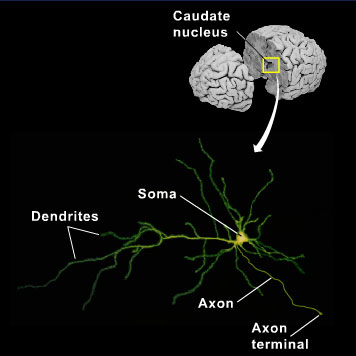Neurons are the principal cells of the brain; they comprise a cell body (or soma), dendrites and an axon that ends at a terminal (Figure 4). The cell body contains the nucleus where DNA resides along with the nuclear machinery to direct the synthesis of proteins. The cell body is also the part of the cell in which an electrical impulse is generated. The dendrites form a branching structure off of the cell body and act as receivers. Neurotransmitters and drugs1 bind to receptors2 on dendrites that trigger membrane currents to promote or inhibit the electrical impulse generated in the cell body. The electrical impulse travels down the axon to the terminal where neurotransmitters are synthesized, stored and then released.
Figure 4 A real neuron filled with a yellow dye shows its structure.

Definitions:
1 a substance that affects the structure or function of a cell or organism.
2 a protein to which hormones, neurotransmitters and drugs bind. They are usually located on cell membranes and elicit a function once bound.
